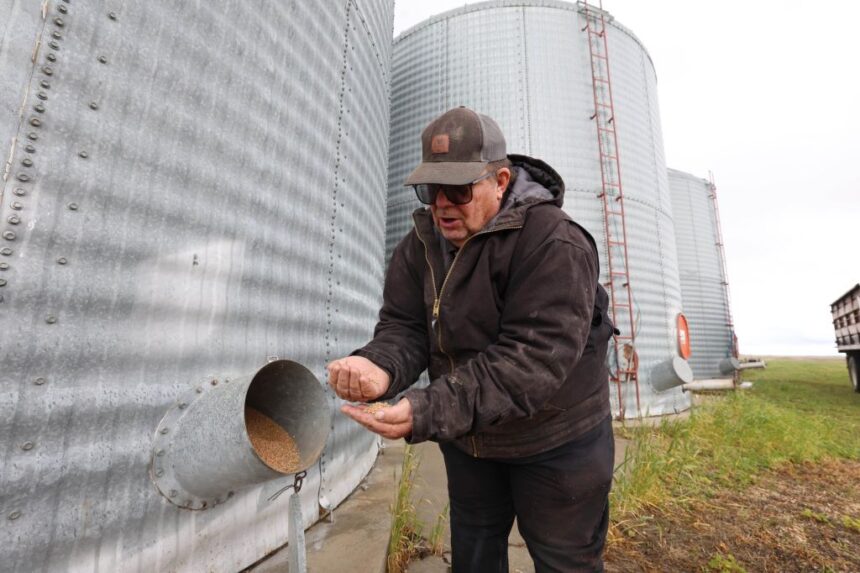Tariff turmoil, extreme drought, late-season rain, wildfire smoke, a change in federal government: to say it’s been an atypical year on the farm would be an understatement. Then again, as most farmers are quick to point out, there’s really no such thing as a typical farming season.By all accounts, the crop has been strong. Yields are above average for canola and wheat, despite early season heat waves, dry conditions and smoky skies. In fact, those factors probably helped. The onset of endless fall rain has been a bigger challenge for farmers as they race to finish harvest and prepare the fields for spring seeding — but it’s nothing they haven’t faced before. Tariffs are a more uncomfortable reality. China has levelled a 75 per cent levy on canola — one of Manitoba’s most important crops — on top of a slate of ever-shifting tariffs from the province’s biggest market: the United States. Market prices have taken a hit, putting pressure on farmers to find buyers for their bumper crops. Not to mention the steady increase in expenses — even as the carbon tax disappeared — as tariffs trickle down the supply chain and notch up the price of farm equipment and inputs. And yet, on Manitoba’s farms, optimism prevails. As harvest comes to an end and the agricultural world starts preparing for another season, four southern Manitoba farmers reflect on the year’s unique challenges — and their hopes for the coming year. Farming has always been a challenging endeavour, so while it’s been a particularly volatile year for many farmers, optimism remains. Photo: Ruth Bonneville / Winnipeg Free Press A summer of drought and smoke By the numbers, this summer could have been a disaster for crops. Drought has been common on the Prairies for many summers now; severe dry conditions struck in 2021 and 2023, and the 2025 growing season seemed off to a similar start. Manitoba saw an uncharacteristically early heat wave in May, then a single bout of heavy rain. Throughout much of the southern part of the province, there was hardly more than a few inches of precipitation through the early months of summer. The Interlake region experienced one-in-10-year severe drought conditions through June, July and August. Some areas reached the one-in-20-year extreme drought threshold. But on Colin Penner’s 3,700-acre family farm, all that dry weather turned out to be a bright spot. Penner runs the Elm Creek-area farm with his brother and not-quite-retired father, where he grows a blend of grains. This year, the Penners focused on soybeans, canola, wheat and oats. It’s a Friday morning in mid-October and ideally, Penner would be on the field getting the soil ready for spring. But it’s been drizzling for a couple days, and there’s not much use sending machinery out in the thick Red River valley clay, so he’s spending his time catching up on the long to-do list on his shop whiteboard. As for the weather this year, he says, the drought wasn’t such a bad thing. In Starbuck, just a 30-kilometre drive northeast of Elm Creek, third-generation farmer Chuck Fossay’s canola, wheat, soybean and oat crops were similarly successful in spite of the early setbacks caused by drought. He attributes some of that success to the natural qualities of wheat and barley, which tend to fare well in dry weather. But there was another unique feature that Fossay and many other farmers believe brought a little respite this summer. High on the banks of the Souris River on the other side of the province, near the village of Treesbank, beekeeper Mike Clark was admittedly a little grateful for the smoke cover, too. After suffering the loss of nearly all his bees — about $1.8 million worth — to a parasitic mite in 2022, Clark has been in the midst of a precarious rebuild. In recent years, commercial beekeepers like Clark, who sells his honey to Manitoba-based BeeMaid, have lost an average of 40 per cent of their bees every year, a level he calls unsustainable. Pesticide-resistant mites and fluctuating temperatures in the shoulder seasons have put additional pressure on an industry already battling to stay afloat. Smoke can be a problem for beekeepers, but Clark says the wildfires likely helped more than they hurt him this year. Little research has been dedicated to understanding the effects wildfires and smoke can have on agricultural production. So far, agronomists mostly agree the impacts can vary widely. There are obvious downsides, for example, for livestock producers whose animals are undoubtedly affected by spending hours breathing in toxic wildfire smoke. Smoky air also lets less light through, which can slow growth for some — but not all — crops. Anecdotally, farmers believe this year’s smoke meant better yields, but the poor air quality didn’t come without challenges for an industry that often requires long hours of outdoor labour. And then came the rain It’s not the drought that’s strained agricultural producers this year — it was the rain. Near Minto, just a short drive southwest from Treesbank, Jake Ayre steers a pickup truck through the maze of dirt and gravel roads that criss-cross the farmland in the Souris River valley. He points through the window at field after field of cornstalks — some of the last crops left to harvest. Ayre would like to be on the combine, but the ground’s still soggy from the weeks of wet weather, and the machines are prone to sinking in the mud. Corn can handle a late harvest, though. Next week, if the ground dries up, he’ll give it another try. To mitigate risk, Ayre’s farm grows a wide variety of crops — pinto beans, navy beans, corn, soybeans, wheat, barley, oats, winter wheat, grasses, pulses. The southwest saw a little more rain than other parts of the province this year, Ayre says, reaching about 40 to 50 per cent of the average annual precipitation through the summer. As fall arrived and harvest picked up pace, the rain became a little punishing for several southwestern farms, which saw as much as 200 per cent of normal precipitation levels. He points to a row of grain bins, each full of oats originally destined for the United States. Taking crop to market Finding buyers for crops is hard enough, but this year posed unprecedented challenges. Since U.S. President Donald Trump took office in January and started to threaten, then implement, a complex web of tariffs, Canadian farmers have been at the mercy of rapid twists and turns in global markets. In between the hard farm work near Starbuck, Fossay sits on the Canola Council of Canada’s board of directors and the board of Manitoba Canola Growers, where tariffs have been a central talking point all season long. As a result, he says, reclining in a rolling office chair at the back of his workshop, “I probably know more about tariffs than most farmers do.” A year ago, he explains, canola prices were around $11 to $12 per bushel; today they’re just over $13. That increase can be traced, at least in part, to growth in the domestic canola crushing industry, which can now process almost 60 per cent of this year’s crop. There’s also growing demand for canola oil in bio-fuels like renewable diesel, which uses cooking oils as a substitute for petroleum. Environmental mandates are driving demand for biofuel, which in turn opens up new markets for Canadian canola. Imperial Oil recently finished construction of a renewable diesel production plant near Edmonton that is expected to consume a million tonnes of oil [equivalent to two million tonnes of seed], Fossay says, meaning the domestic market is growing too. Beekeepers like Clark are making the most of tariffs, too. He sees the American levies as a way to stabilize the market price of honey, which has dropped in recent years owing to an influx of cheap, “fraudulent” honey — mixed with flavoured corn or rice syrup — from east and south Asia. But tariffs are affecting more than the market price of goods. Back in the Elm Creek workshop — a lofty barn with an elaborate workstation along one wall — Penner hoists a muffler from where it’s temporarily bolted to a 40-year-old tractor. He’d normally buy a replacement, but today the part he needs would cost between $3,000 and $4,000 because of tariffs and supply-chain disruption. Instead he went to a truck shop, found a similar part for about a tenth of the price, and is learning how to modify it to fit his machine. Just off Highway 1, on the edge of the town of Elie, Matt Tkachyk sits in a corner office at Rocky Mountain Equipment, a farm equipment dealer where he sells “everything that helps put the crop in and take the crop off: combines, sprayers, tractors, seeders, tillage equipment, planting equipment.” The machines he sells typically cost north of a million dollars. Tkachyk says it’s difficult to give an apples-to-apples comparison of costs before and after tariffs because other factors like inflation have played a significant role, but he’s seen costs climb anywhere from three to eight per cent — tens of thousands of dollars — since the levies came into effect. The dealership has been here as long as Tkachyk can remember, though under different names over the years. Having grown up in the area, Tkachyk knows his customers well. In a year where tariffs have rocked the automotive industry and prompted price hikes across supply chains, he’s been doing everything he can to protect those customers from the impacts, and he’s watching them adapt in real time. Planning for the future Uncertainty, on the farm, is par for course. This season had its challenges, but all seasons do. “I think every farmer has to be an optimist,” Penner says, reflecting on the year. “We’re gamblers,” says Ayre, driving back onto the home section of his sprawling farm. “At the end of the day it’s living, breathing things. You can’t control every aspect of it, so you just kind of hope for the best. The quote is: you’re always two weeks away from a drought and two days away from a flood. It’s different every day. Every year is chaotic in its own way. There’s always something.” Clark, the beekeeper, is holding on to gratitude through the sleepless, uncertain nights. “I would say this year turned out better than I thought,” he says. “Lately I’m just trying to be grateful for what we have — even if it’s not what I want. You know, my bees are healthy right now; this whole spring it was just me and my sister and it was kind of nice to do everything yourself and take a little bit more pride.” Mike Clark is a third-generation beekeeper, and runs the apiary his grandfather started in 1914. Though 2025 was a challenging year, he says he’s grateful for what he has — ”even if it’s not what I want.“ Photos: Mike Deal / Winnipeg Free Press Fossay has seen it all over his years on the farm by Starbuck. He’s 71 now and the oldest of nine siblings. He remembers his dad farming through much more challenging seasons in the late ’60s. He’s seen the markets rise and fall. Though he’ll acknowledge this season was far from perfect, “it could have been a whole lot worse.” “It’s not a job where you’re guaranteed income every year,” Fossay says. “You’ve got to deal with drought, excess moisture, sometimes both, sometimes it’s insects — grasshoppers, locusts — sometimes the market.” “There’s a lot of things that we can’t control, so you always have to be patient. It’s always next year. If it’s bad this year, next year will be better.” Julia-Simone Rutgers is a reporter covering environmental issues in Manitoba. Her position is part of a partnership between The Narwhal and the Winnipeg Free Press. Recent Posts What was it like to farm in 2025? Canadian farmers weigh in Oct. 24, 2025 16 min. read Does wildfire smoke help crops? Do tariffs boost honey prices? The intricacies of farming in… Canada’s spy agency now shares intel with corporations — thanks to a push from TC Energy Documents reveal Canada’s biggest corporations successfully lobbied the federal government for changes that enable access… Ontario is heading down a dangerous road with special economic zones Oct. 22, 2025 3 min. read From Mexico to China, global examples of areas where laws are lifted in the name…
What was it like to farm in 2025? Canadian farmers weigh in











